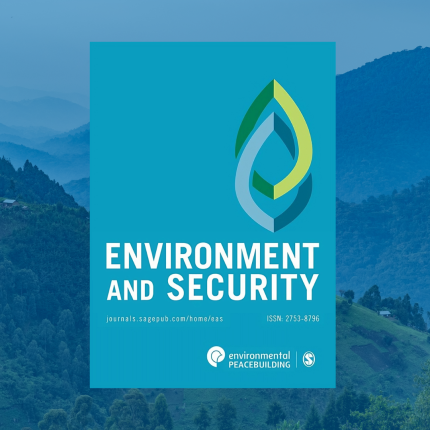-
Environment and Security | Q&A with Editor in Chief, Ashok Swain
January 22, 2024 By Wilson Center Staff
From Afghanistan, Nepal, and Libya to the Arctic, the new issue of Environment and Security takes a fresh look at emerging issues at the intersection of environment and security. Ashok Swain, Editor in Chief of Environment and Security, spotlights some of the new research and insights in this Q&A with ECSP staff.
Q: The new issue of Environment and Security features an article on Arctic governance, including a close examination of the International Code for Ships Operating in Polar Waters (Polar Code). How do the authors assess this regulatory instrument as it enters its 10th year since adoption?
Ashok Swain: Liselotte Odgaard and Kathryn C Lavelle’s comprehensive analysis of the Arctic Council, the International Maritime Organization (IMO), and the International Code for Ships Operating in Polar Waters Polar Code, highlights the complex interplay between environmental stewardship and maritime regulations in the Arctic. The focal point of their study is the Polar Code, a landmark 2014 IMO initiative aimed at tackling the increasing challenges and environmental risks associated with polar shipping. They delve not only into the factors that spurred the adoption of the Polar Code, but also its repercussions for environmental peacebuilding through the connection of maritime safety with critical environmental issues such as oil spills. Despite hurdles including inadequate coordination among international bodies and the persistent use of heavy fuel oil, the Polar Code has been a pivotal advance in establishing primary and secondary institutions for environmental governance. The authors also observe that despite the Polar Code’s limitations, its ongoing evolution as an environmental framework in the Arctic could shed light on the potential far-reaching influence of norms in other regions.

An ice breaking ship, courtesy of LuYago/Shutterstock.com
Q: Another article in the issue explores how climate change and other environmental shifts are reshaping the landscape of peace and conflict in Afghanistan and Nepal. What conclusions do these researchers draw about the larger arc of transformation from these specific locales?
AS: The fieldwork performed in Afghanistan and Nepal by Dahlia Simangan, Srinjoy Bose, John Lee Candelaria, Florian Krampe, and Shinji Kaneko is the foundation for an article that expands our understanding of environmental peacebuilding from a grassroots perspective. The authors bring to light how non-violent security concerns in these regions (deteriorating water quality and the menace posed by wildlife) are often overlooked in traditional security discussions. Government inaction, mismanagement, and corruption exacerbates the vulnerability of communities to environmental hazards, impeding progress towards achieving both peace and environmental sustainability. The article observes how in both Afghanistan and Nepal, the lack of strong political legitimacy and cohesion is closely linked to security issues that erode the foundations of peace and sustainability. Because political legitimacy and cohesion are vital in strengthening local resilience against conflict and environmental change, the conclusions of this research are pivotal to advocacy for more bottom-up approaches in environmental peacebuilding.

Flooding in Kathmandu, Nepal, courtesy of gorkhe1980/Shutterstock.com
Q: Other articles in the issue draw upon research on specific locales (Mozambique, Libya) and discrete phenomena (non-state armed groups, environmental justice). How does this variety of perspectives enhance the journal’s mission to highlight the urgent need for nuanced and multifaceted strategies to address an increasingly complex relationship?
AS: In a world where the nexus of natural disasters, conflict, and resource management increasingly shapes geopolitical landscapes, the remaining articles in our new issue offer critical insights into these complex dynamics and advocate for a holistic approach to environmental justice in conflict-impacted areas.
Benjamin E Bagozzi, Thomas S Benson, and Ore Koren examine the intersection of natural disasters and conflict, particularly in the context of the Cabo Delgado insurgency, using time series analysis and qualitative evaluations to link cyclones with escalated violence against civilians in specific insurgencies. Juliane Schillinger and Gül Özerol focus on the role played by non-state armed groups (NSAGs) in water service provision, infrastructure development, and policy-making in the Middle East. This empirical approach to examining NSAGs in different regions—Gaza Strip, northern Yemen, and Northeastern Syria—sheds light on the complexities of water governance in conflict zones.

An aerial view of a flooded village in Mozambique after a cyclone, courtesy of Wirestock Creators/Shutterstock.com
Post-2011 revolution Libya presents a unique case of how large-scale, centralized water and energy infrastructures become focal points in prolonged conflicts. Erika Weinthal and Jeannie Sower’s articles unpacks the politics of energy and water in Libya’s rentier economy, illustrating how local communities, militias, and warlords exploit these infrastructures. And, finally, Ambreen Tour Ben-Shmuel and Silja Halle’s offer a practitioner perspective which emphasizes the need for a comprehensive approach that integrates environmental, social, and political considerations. Their call for genuine environmental justice efforts, beyond superficial greenwashing, is particularly relevant in areas impacted by conflict.
These articles underscore the intricate and often overlooked connections between environmental factors and security issues, and highlight the necessity of adopting multifaceted strategies that consider both phenomena in conflict and post-conflict settings. Creating sustainable peace and security and addressing the underlying causes of conflict requires adopting such a vision.
Ashok Swain, Ph.D., is a professor of peace and conflict research at Uppsala University and Editor in Chief of Environment and Security.
Sources: Sage Journals, Environment and Security Journal
Header Photo credit: Graphic created from the cover of the Environment and Security Journal and USAID Measuring Impact Conservation Enterprise Retrospective project, courtesy of Flickr user USIAD Biodiversity & Forestry.
 A Publication of the Stimson Center.
A Publication of the Stimson Center.






